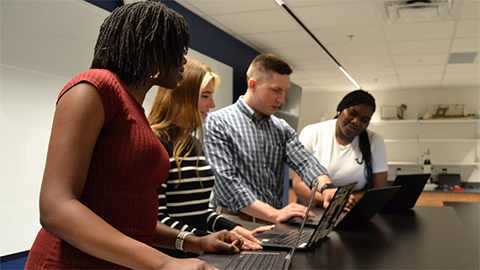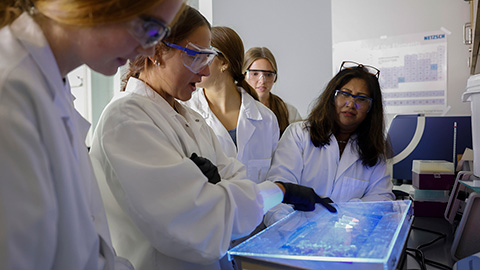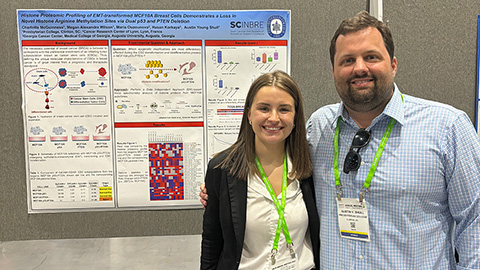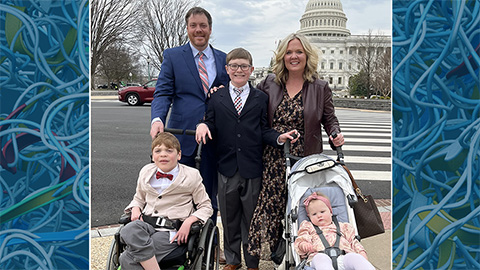The joys of doing research with undergraduates
Although I now have been retired for a few years, I had two publications come out recently with former undergraduates as first authors. This prompts me to reflect on undergraduate research experiences from a faculty member’s point of view.
Much has been written about the benefits of undergraduate research for students. It is considered a high-impact practice, and multiple projects exist to expand the opportunity to all students via course-based undergraduate research experiences, known as CUREs, or other models.
We see less discussion of what undergraduate research does for faculty. And such discussions tend to focus on the disadvantages for faculty — students in the lab decrease productivity, it’s not fair that faculty in other fields don’t have to involve undergraduates in their scholarship, by the time students know enough to be helpful they have graduated, and so on.
These complaints all contain some truth and should be taken into account by administrators when it comes to tenure and promotion decisions. But I have found many reasons to work with undergraduates, and it is not exaggerating to use the term “joys” in the title of this essay.
Among the many reasons to work with undergraduates:
They are impatient. They have four years at most in the lab. Those who already know about research will be knocking on your door the first day they are on campus, and those who learn about research when they take classes will be even more anxious to make up for lost time. This impatience is a great impetus for a new faculty member to get moving on research when they might otherwise be overwhelmed with course preparation and settling in. I never would have gotten into my own lab during my first semester teaching if it hadn’t been for students eager to get involved.

They force you to think in short, self-contained projects. Not all research projects are suitable for undergraduates; for example, you likely will not want to build new instruments or develop new animal models (although both are possible if your tenure committee is patient). But small projects that can be completed in a few years can accumulate to major findings and are nice to have in hand for preliminary data. Some of my publications resulted from individual student projects, each following up on a single amino acid substitution in an enzyme or the effects of stresses on a single bacterial strain. Numerous CUREs are based on this principle: many small contributions to a larger project.
They are enthusiastic and will do anything in the lab. You don’t want to stick your undergraduates with all the menial tasks, but there is certainly lots of routine work, such as making solutions and ordering/unpacking supplies, that they are happy to do as long as they are learning and contributing.
They do not require lots of monetary resources. Unlike graduate students, for whom you might have to pay tuition and stipends, undergraduates usually do not need much funding. Resources for summer stipends and work-study can be found, and if the students are earning academic credit for research, the credit is their compensation.
Their careers are not bound up in yours. You probably will write them recommendation letters, but undergraduates are unlikely to rely on your reputation in the same way that grad students and postdocs do. This means they are freer to leave for another lab (or leave research altogether) without hard feelings, which is likely healthy for you and your department.
They offer a different lens through which to see the students in your classes. That is to say, they help you to be a better teacher. Students who traditionally are considered successful in academic work have a certain set of skills and attitudes, which may or may not be the same as the skills and attitudes needed to succeed in research. They might be afraid of failure and often don’t like to ask for help. Students who are perhaps not the top of their class in terms of grades but are great in the lab recognize mistakes as opportunities to learn and are likely to embrace collaboration. Working with such students has helped me appreciate the many types of intelligence among the students in my classes and prompted me to include more teamwork and revision in assignments. By talking informally with them in the lab, I gained insight into students’ thinking about scientific ideas and misconceptions.
They create a community that allows you to see the potential scientist in every student. Undergraduate research is powerful because just being part of a research group helps to build a student’s identity as a scientist. This is particularly important for students from groups that historically have been excluded from scientific fields. But this is a two-way transaction; I also have benefitted from seeing students in my labs who broadened my definition of a scientist — whether students of color, those with disabilities or those returning to school after years at home or in the workforce.
I am sure my colleagues who regularly work with undergraduates in their labs will find my catalog of advantages to be commonsensical and will add more to the list. But for those faculty just starting out in academic careers, especially those who have spent their training exclusively in graduate institutions, I hope that these ideas will spark an interest in working with undergraduates and perhaps building a research program around them.
Enjoy reading ASBMB Today?
Become a member to receive the print edition four times a year and the digital edition monthly.
Learn moreFeatured jobs
from the ASBMB career center
Get the latest from ASBMB Today
Enter your email address, and we’ll send you a weekly email with recent articles, interviews and more.
Latest in Opinions
Opinions highlights or most popular articles

Debugging my code and teaching with ChatGPT
AI tools like ChatGPT have changed the way an assistant professor teaches and does research. But, he asserts that real growth still comes from struggle, and educators must help students use AI wisely — as scaffolds, not shortcuts.

AI in the lab: The power of smarter questions
An assistant professor discusses AI's evolution from a buzzword to a trusted research partner. It helps streamline reviews, troubleshoot code, save time and spark ideas, but its success relies on combining AI with expertise and critical thinking.

How AlphaFold transformed my classroom into a research lab
A high school science teacher reflects on how AI-integrated technologies help her students ponder realistic research questions with hands-on learning.

Writing with AI turns chaos into clarity
Associate professor shares how generative AI, used as a creative whiteboard, helps scientists refine ideas, structure complexity and sharpen clarity — transforming the messy process of discovery into compelling science writing.

Teaching AI to listen
A computational medicine graduate student reflects on building natural language processing tools that extract meaning from messy clinical notes — transforming how we identify genetic risk while redefining what it means to listen in science.

What’s in a diagnosis?
When Jessica Foglio’s son Ben was first diagnosed with cerebral palsy, the label didn’t feel right. Whole exome sequencing revealed a rare disorder called Salla disease. Now Jessica is building community and driving research for answers.

